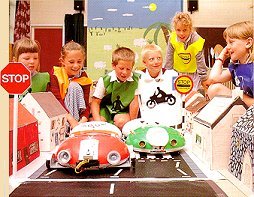
|
Feedback Form

WHY DID THE ROAMER CROSS THE ROAD?

How to make road safety lessons interesting was the challenge facing Mrs Lesley Podmore, deputy head teacher at Bramford County Primary School in Ipswich. While she was attending a course organised by Suffolk County Council Road Safety Department, she saw the potential of the Roamer. When she mentioned the idea to Martin Andrew, who was running the course, he offered to help her set up some projects. GO visited the school recently and found that the children had developed some interesting applications.
 Mr Andrew provided the
school with a 'road-mat' which has realistic road markings including white
lines, junctions and two zebra crossings. Mrs Podmore set out the mat
on the floor of the assembly room and got to work with a group of six
to eight year old pupils of varied ability. Older children contributed
to the project by building a realistic model village. The pedestrians
were played by a family of furry badgers!
Mr Andrew provided the
school with a 'road-mat' which has realistic road markings including white
lines, junctions and two zebra crossings. Mrs Podmore set out the mat
on the floor of the assembly room and got to work with a group of six
to eight year old pupils of varied ability. Older children contributed
to the project by building a realistic model village. The pedestrians
were played by a family of furry badgers!
Once the stage was set, the younger children began to examine safety issues. Working in pairs, the children were asked to put themselves in the position of the motorist with the Roamer taking on the role of a programmable car. The activity was worked in stages - children had to make the Roamer go forward and stop at the T-junction. It also had to stop if pedestrians were at the zebra crossing.
The next stage was to make the Roamer car turn left to check for oncoming traffic (it had to only look in one direction as it was a one-way system) before turning right into the one-way High Street and proceeding to the next zebra crossing. A valuable lesson was learned early on, according to Mrs Podmore.
"At first the children turned the Roamer 90° but they soon realised that a real driver would not look the full way round so they programmed it to turn just 50° to the left."
Finally they programmed the Roamer to continue to the next T-junction where it stopped again and turned right into an adjoining road. Mrs Podmore encouraged the children to write down the moves as they were making them and to discuss what went wrong if they went through a zebra crossing or through a T-junction without checking. Those children who grasped the essentials were then asked to write down the moves before they pressed GO so that they had one complete sequence. Within two hours of his introduction to the Roamer, one pupil was able to complete the entire course successfully in this manner.
The object of the activity is to make children aware of the dangers which they face in an everyday situation and Martin Andrew, while admitting that it is difficult to judge the effectiveness of the project, believes this innovative way of teaching vital skills provides a welcome alternative to dry lectures on the subject. As well as the road safety aspect, the exercise helps the children to appreciate the basics of measuring distance and judging angles.
"It took them ten minutes to grasp how angles work, since they wanted to make the Roamer turn right at a T-junction - a lesson that would have taken 45 minutes or more on a blackboard. The main lesson they have learned, though, is not to trust drivers!"
Mrs Podmore intends to set up several new projects next term, one of which will involve the children building a tunnel.
| Green-Cross Code
Make the Roamer into a pedestrian. Program the Roamer to cross the road. Let the Roamer move to the kerb edge. Program it to look right, left then right again and if its all clear cross the road. Make a roadside kerb with cars parked, zebra crossings, traffic lights, etc. Program the Roamer to find the best place to cross the road. Then program it to perform the Green Cross Code.Developed from an idea by HUMMEC. |
| Back |
|---|